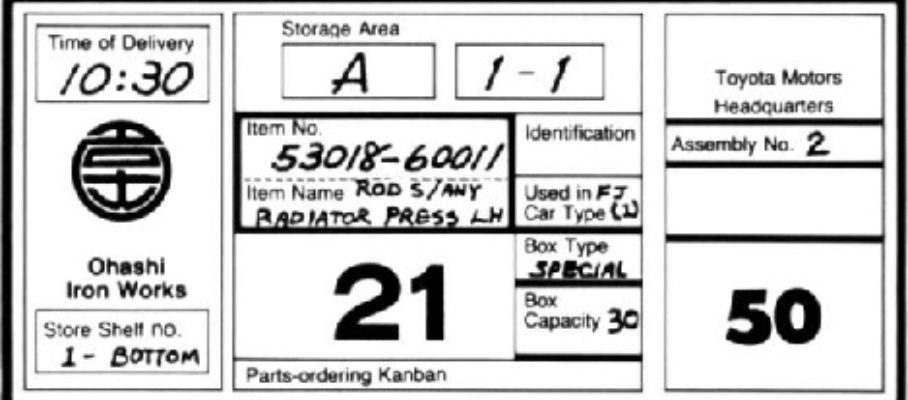Dec 9 2011
Sundaram-Clayton wins Platinum in India Manufacturing Excellence Awards
Via Scoop.it – lean manufacturing

Continuing our round-the-world tour of awards, prizes and cups for Lean Manufacturing.
Via www.wheelsunplugged.com
The pursuit of concurrent improvement in all dimensions of manufacturing performance through projects involving both the production floor and support services.
Dec 9 2011
Via Scoop.it – lean manufacturing

Continuing our round-the-world tour of awards, prizes and cups for Lean Manufacturing.
Via www.wheelsunplugged.com
By Michel Baudin • Press clippings 0 • Tags: Awards, Lean manufacturing, Management

Dec 7 2011
Wiegand’s Watch is a monthly letter from Dr. Bodo Wiegand, who runs the Lean Management Institut, the German affiliate of the Lean Enterprise Institute. This month, he focuses on what he perceives to be a wasted use of email and cell phones in the development of the Citroen C5 car. Following is a translation of his letter, followed by my comments:
€ 16 million wasted in the development of the C5 car
Today I was at the airport and saw a billboard.
The development of the C5 at Citroen used 1,410,475 cell phone calls and 3,155,546 e-mails. This is madness. If a phone conversation lasts an average of 2.5 minutes, it works out to 14 670 man-days or 73 man-years.
Assuming writing a technical e-mail on average takes four minutes and that it is read six-times, then these emails took up 65,741 man-days or 321 man-years. Assuming that 50% of these cell phone calls and 50% of e-mails were necessary but non value-added, this adds up to 40,000 man-days or 200 man-years, or € 16 million were needed to do the following:
- Fix processes that are out of control.
- Define nterfaces that were not specified.
- Rethink procedures with qualitative gaps.
- To answer questions.
- To solve problems.
What a huge waste!
What a potential for improvement!
And Citroen boasts about it.
My first reaction is to wonder what is wrong with >1,000 people involved in a multi-year project like the development of a new car communicating extensively? It brings to mind Frederick Brooks’s famous audit of the Tower of Babel project in The Mythical Man-Month. The goal was clear and its lack of feasibility played no part in the failure. Human and material resources were plentiful in Mesopotamia, and were not a problem either. What caused the project to fail was that team members could not communicate.
Product development generates many documents that need to be reviewed, discussed, annotated, updated, revised, and organized. These documents must also be available easily to all those with a need to know, and kept secret from all others. I don’t know on what basis Dr. Wiegand concludes that a large part of Citroen’s communications by phone and email were waste. For all I know, they may have been meaty technical exchanges that improved the design of the C5…
Of course, you don’t need electronic means of communication if everybody is in one big room, but that only works for teams that are small enough. You would need a convention hall for a team in the latter stages of car development, and some activities, like testing in a hot desert or snow, or ramping up production, take place at multiple locations. While always desirable, face-to-face communication is not feasible for everything at all times.
Just based on the statements from Citroen, if I would fault them for anything, it would be for relying on nothing more sophisticated than phones and emails, which is so 20th century. There are now collaboration and on-line meeting tools that combine much richer exchanges with better data security and revision control. For example, engineers at different locations can view the same drawing on their screens, annotate it while discussing through an audio conference, and read each other’s body language through webcams.
Instead of having multiple copies of documents floating around in individual mailboxes, you can keep them in a library on a server to ensure that all participants in a discussion are looking at the same version, and to prevent these documents from leaking out.
You can also fault emails for lacking the kind of structure you find in A3 reports, which discipline authors in providing particular data items while helping readers find them. But again, more advanced communication tools can provide that structure through on-line forms .
For voice communication, there are also alternatives to cell phones. For people whose work causes them to move around within the range of WIFI network, for example, there are wearable devices that allow them to call each other by name and communicate by voice instantly, as if they were side by side.
So maybe the issue is not that Citroen C5 development used to many engineer-years communicating, but that, next time, they should use the state of the art to do it.
By Michel Baudin • Blog clippings, Management 3 • Tags: A3, Lean manufacturing, Manufacturing engineering, Project management
Dec 1 2011
Via Scoop.it – lean manufacturing
RUSSIA: Alstom Transport is to provide Russian Railways specialists with training in the implementation of lean manufacturing technology under a memorandum of co-operation which was signed during the Second Railway Congress in Moscow on November 19.
Via www.railwaygazette.com
By Michel Baudin • Press clippings 0 • Tags: Lean manufacturing

Dec 1 2011
Steven Spear’s The Essence of Just-in-Time:Imbedding diagnostic tests in work-systems to achieve operational excellence is a working paper from Harvard Business School in 2002 focused on the interaction between JIT and problem-solving. It is an important topic, only briefly alluded to in Lean Logistics and covered in more detail in When to Use Statistics, One-Piece Flow, or Mistake-Proofing to Improve Quality, but there are many other improvement opportunities besides product quality, and shining a light on their relationship with JIT is useful.
Spear’s paper is worth reading because he did his homework: it is based on research that involved immersion in a Toyota supplier support team, visits to seven Toyota plants and 12 suppliers in Japan and the US, and working as an assembler in a non-Toyota plant for comparison. I recommend in particular sections 4 to 7. Section 4 is a case study of mattress manufacturing at Aisin Seiki, from which the following sections draw general conclusions.
You have to look past the other sections, which mainly reflect Spear’s membership in the academia tribe. His research is described as an “ethnographic study,” which conjures up the image of an American or European spending 15 years among the Guaranis of Paraguay recording what they are willing to share of their language and culture. That this vocabulary should be used in a study of Lean reflects how alien the world of manufacturing is to academia.
As an academic, Spear is obligated to reference other academics, but not non-members of the tribe, no matter how major their contributions. For example, the only Japanese author in the bibliography is Takahiro Fujimoto, from the University of Tokyo, but neither Taiichi Ohno nor Shigeo Shingo appear. Section 3, on Methods, opens with “Many scholars argue…” With all due respect, the arguments of scholars don’t amount to a hill of beans in Manufacturing, because, unlike Computer Science or Biology, it is not a field to which they have contributed much. From Taylor and Gastev to Ohno and Shingo, the key innovators in Manufacturing have almost all been self-taught, Lillian Gilbreth being the exception with a PhD. Why was Spear’s research not done in an Industrial Engineering department, where its content would normally place it? As I found in my own ethnographic studies of academia, the need for grants pushes researchers in other directions, like genetic algorithms.
By Michel Baudin • Management 2 • Tags: JIT, Just-in-time, Lean manufacturing, Ohno, problem-solving, Shingo, Takahiro Fujimoto, Toyota

Nov 29 2011
Ever since the world outside of Toyota started noticing its production system in the late 1970s, the Kanban system has received a disproportionate amount of attention compared to other features. It does not mean, however, that it has been accurately implemented in many of the factories that claim to have done it. To anyone who cared to study it, details have been available in English at least since Robert Hall’s Zero Inventories (1983), the JMA’s Kanban, Just-In-Time at Toyota (1985), Yasuhiro Monden’s Toyota Production System (1993), or an updated treatment in Lean Logistics (2005).
Pressured to implement Kanbans by executives to whom it was little more than a buzzword, many manufacturing professionals found it more expedient to take old, familiar approaches like the two-bin system or reorder-point and call them Kanban. One such system implementing reorder-point through cards placed on a board has become so popular in France that I suggested calling it “French Kanban.” As can be seen in Figure 1, each column on the board is a mirror of the inventory level for an item. Each pocket filled by a card corresponds to an empty slot in stores, so that the remaining amount is visually indicated by the empty pockets on top. The reorder point is crossed when the cards reach the red zone.
 Figure 1. French Kanban: Reorder-Point with Cards
Figure 1. French Kanban: Reorder-Point with Cards
Meanwhile, a few academics like J.T. Black at Auburn University or Robert Hall at Indiana University took the trouble to thoroughly investigate the Toyota system as a whole and the Kanban system in particular, but most of their colleagues didn’t, preferring a simplistic rendition of the Kanban system that made their own ideas stand out by contrast. In this context, insisting on the genuine Kanban system is perceived as nitpicking, because the differences are not in the big idea but in the details. You can easily dismiss these details as insignificant until you consider their cumulative effect on thousands of shop floor transactions every day.
Here are two examples, found today in a blog post:
When evaluating or learning a tool like the Kanban system, you have to consider the following:
Within its range of applicability, the Kanban system is both simple enough for people to apply and sophisticated enough to get the job done. This is a tall order, and we should not underestimate what it takes.
Even in Japanese, the word Kanban has many different meanings, the most common being a sign advertising a store on the street, as you can see by searching Google images for “看板” (Kanban). Figure 2 shows, on a sidewalk, the Kanban of a beauty salon located on the 2nd floor of the building.
 Figure 2. A Kanban in everyday Japanese
Figure 2. A Kanban in everyday Japanese
By Michel Baudin • Technology 3 • Tags: Kanban, Lean manufacturing, Toyota
Dec 11 2011
Russian Lean Blog Post about Cultural Differences
Via Scoop.it – lean manufacturing

This is a translation of my own comments in this discussion:
Share this:
Like this:
By Michel Baudin • Blog clippings 0 • Tags: Lean, Lean manufacturing, Management